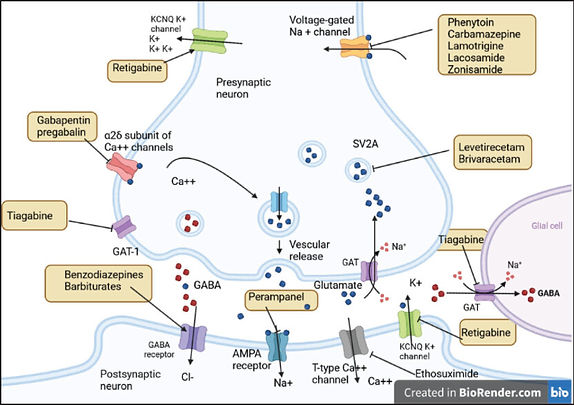
A
N
T
I
-
E
I
L
P
E
P
T
I
C
D
R
U
G
S
UNDERSTANDING ANTI-EPILEPTIC DRUGS (AEDs): AN EDUCATIONAL SERIES FOR PARENTS
Welcome to our educational series dedicated to helping parents understand Anti-
Epileptic Drugs (AEDs) and their vital role in managing epilepsy. This series aims to
provide you with comprehensive knowledge about how AEDs work and the importance
of bringing epilepsy under control.
What Are Anti-Epileptic Drugs (AEDs)?
Anti-Epileptic Drugs (AEDs), also known as anticonvulsants, are medications used to
prevent and control seizures in individuals with epilepsy. These drugs work by
stabilizing electrical activity in the brain, preventing the abnormal surges that cause
seizures.
How Do AEDs Work?
1. Regulating Ion Channels:
AEDs help to balance the function of sodium, calcium and potassium channels in the brain. By preventing the rapid firing of neurons, these medications reduce the likelihood of seizures occurring.
2. Blocking Excitatory Pathways:
Some AEDs work by blocking certain neurotransmitters, such as glutamate, that can trigger excessive neuronal firing. By inhibiting these pathways, AEDs help to prevent the onset of seizures.
3. Enhancing Inhibitory Signals:
Other AEDs enhance the action of inhibitory neurotransmitters like gamma-aminobutyric acid (GABA), which naturally calms neuronal activity. This helps to counteract the hyperexcitability seen in epilepsy.

Image courtesy of Biorender & Nashed, M. (2023). Mechanisms of Antiepileptic Drugs.
TYPES OF AED'S
Sodium Channel Blockers: Prevent rapid firing of neurons by blocking sodium channels (e.g., Phenytoin, Carbamazepine).
Calcium Channel Blockers: Reduce neurotransmitter release by blocking calcium channels (e.g., Ethosuximide).
GABA Enhancers: Increase the inhibitory effects of GABA, an inhibitory neurotransmitter (e.g., Valproate, benzodiazepines).
Glutamate Inhibitors: Reduce the excitatory effects of glutamate, an excitatory neurotransmitter (e.g., Topiramate).
Keppra (Levetiracetam): Keppra interacts with the SV2 protein and helps control the release of neurotransmitters. This helps regulate brain activity and inhibits the spread of seizure activity in the brain. It is widely used due to its effectiveness and mild side effect profile.

Image courtesy of Sage Journals
THE IMPORTANCE OF BRINGING
EPILEPSY UNDER CONTROL
Managing epilepsy effectively is crucial for several reasons:
1. Preventing Seizures: Uncontrolled seizures can lead to physical injuries, cognitive decline, and even life-threatening situations. AEDs play a key role in reducing seizure frequency and severity, providing a safer environment for your child.
2. Improving Quality of Life: Consistent seizure control allows children to participate more fully in everyday activities, including school, sports, and social interactions. This can significantly enhance their overall quality of life and development.
3. Protecting Brain Health: Seizures can impact brain function and development. By controlling seizures, AEDs help protect the brain and support better long-term cognitive outcomes.
4. Reducing Stress for Families: Managing epilepsy can effectively reduce healthcare costs related to emergency room visits, hospitalizations, and long-term care. Effective seizure management reduces the constant worry and stress that parents often experience. Knowing that your child’s condition is under control allows for a more stable and peaceful family life.
WORKING WITH HEALTHCARE PROVIDERS
Regular Monitoring: It’s essential to have regular check-ups with your child’s neurologist to monitor the effectiveness of the prescribed AEDs and adjust dosages if necessary.
Understanding Side Effects: Be aware of potential side effects and communicate any concerns with your healthcare provider to ensure the best possible treatment plan.
Staying Informed: Keep yourself updated with the latest research and developments in epilepsy treatment to make informed decisions about your child’s care.
CONCLUSION
Understanding how AEDs work and their importance in managing epilepsy is a vital step in supporting your child’s health. By bringing epilepsy under control, AEDs not only prevent seizures but also improve your child’s quality of life. Stay engaged with your healthcare team, remain informed, and take an active role in your child’s epilepsy management.
For more information and resources, please explore the YWHAG Foundation's comprehensive guides and support materials. Together, we can make a difference in the lives of children with epilepsy.
**Disclaimer**: This educational series is for informational purposes only and should not replace professional medical advice. Always consult with a licensed healthcare provider for any medical concerns.

Thank you to Ava Smith, MBA and PhD student at The University of Alabama at Birmingham, for her invaluable help and support for the YWHAG Foundation with this article to better educate and inform the families we serve.
